What size mountain bike frame do I need? That’s one of the most commonly asked questions by our readers.
Ordering bikes online is becoming more and more popular. Bikes are typically more affordable online than in local bike shops because overhead costs are lower, allowing online stores to sell their bikes at cheaper prices.
But what about the good old rule that says you need to try a bike before buying it? While this can be beneficial, it’s often an overrated method and not necessary for everyone.
If you go to a local bike shop and sit on a bike, you’re more likely to buy it, which is why shopkeepers would like you to do it. But the reality is that most novice riders don’t know how a bike should feel during their first test ride, so this sizing method is not valuable for inexperienced riders.
You should try your bike first! Not completely true!
Even though everyone is built differently, most people’s bodies fall into certain categories in terms of height, inseam length, and arm length. Therefore, unless you’re have an unusual ratio of upper and lower body length, you can trust mountain bike size charts to recommend you the right frame size.
Related: Best Mountain Bikes You Can Get
With that in mind, there are several reliable methods to choose the right mountain bike frame size.
In this article, I’m going to show you how to use mountain bike size charts and online calculators to get the right size and fit in seconds!
Contents
Method #1: Mountain Bike Size Chart
The easiest way to find the correct bike size is by using a mountain bike frame size chart. This is a simple method that lets you compare your height and/or inseam length against a chart that recommends the correct frame size.
Mountain bike frame sizes are measured based on seat tube length, expressed in inches, which typically ranges from 13″ to 24″. Effective top tube length (the horizontal distance between the head tube and the seat tube) plays a role as well, but seat tube length is a more common measurement.
Some manufacturers also use size classes, such as XS, S, M, L, and XL, but these are not as reliable as using inches because the measurements can differ from one brand to another.
What mountain bike frame size do I need? Find the answer in the chart below:
| Rider Height | Suggested Mountain Frame Size | ||
| Feet & Inches | Centimeters | Frame Size (inches) | Size Classes |
| 4’10” – 5’2″ | 148cm – 158cm | 13″ – 14″ | X-Small |
| 5’2″ – 5’6″ | 158cm – 168cm | 15″ – 16″ | Small |
| 5’6″ – 5′ 10″ | 168cm – 178cm | 17″ – 18″ | Medium |
| 5’10” – 6’1″ | 178cm – 185cm | 19″ – 20″ | Large |
| 6’1″ – 6’4″ | 185cm – 193cm | 21″ – 22″ | X-Large |
| 6’4″ – 6’6″ | 193cm – 198cm | 23″ – 24″ | XX-Large |
Bonus tip: If you’re buying a bike on Amazon, you can also check out their Amazon Fit Guide which includes sizing recommendations for adult road bikes, adult mountain bikes, and kids’ bikes.
Related: Best Gravel Bikes You Can Buy
Method #2: Online Bike Size Calculator
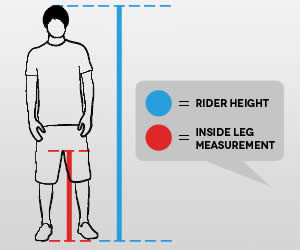 The next best way to find the right mountain bike size based on your height and inseam length is to use an online bike size calculator.
The next best way to find the right mountain bike size based on your height and inseam length is to use an online bike size calculator.
These are interactive tools that let you enter your height and inseam length and then recommend you the correct size or range of sizes to consider.
Before you can use one, you need to learn how to correctly measure your inseam. Here’s a quick step-by-step guide:
- Take off your shoes and stand with your legs 6″ to 8″ (15-20 cm) apart.
- Place a book between your legs, as far up as you can.
- Measure the length from the ground up to the top of the book.
- Voila! This is your inseam length that you can now enter into an online bike size calculator.
When using a bike size calculator, make sure to choose the right type of bike—mountain bike, city bike, or road bike—as the measurements will differ based on that.
If you’re not sure about it, you can read more about the different bike types here.
Here are the top online bike frame size calculators we recommend:
1. Ebicycles.com Online Calculator: An easy way to find the right MTB frame size by using your height and inseam length.
2. Competitive Cyclist Fit Calculator: A more detailed bike fit calculator that lets you know the correct standover height range, top tube length, saddle height, and more.
3. Jenson USA Bike Fit Calculator: Another in-depth bike fit calculator that suggests the right bike size and helps you nail the fit afterward.
Method #3: Mountain Bike Sizing Formula
One of the easiest but also the least reliable methods of finding the right mountain bike size is using a simple mathematical formula that uses your inseam length.
It goes like this:
Leg inseam (cm) x 0.66 = Your frame size
For example, if your leg inseam is 76cm, multiplied by 0.66 then your correct mountain bike size is 20″ (50cm).
This method is only good for approximating the correct size, but we don’t recommend relying on it exclusively. It’s best to combine it with the results you get from the mountain bike size chart and online calculator that we’ve shown you above.
Bonus Tip: Finding the Right Saddle Height
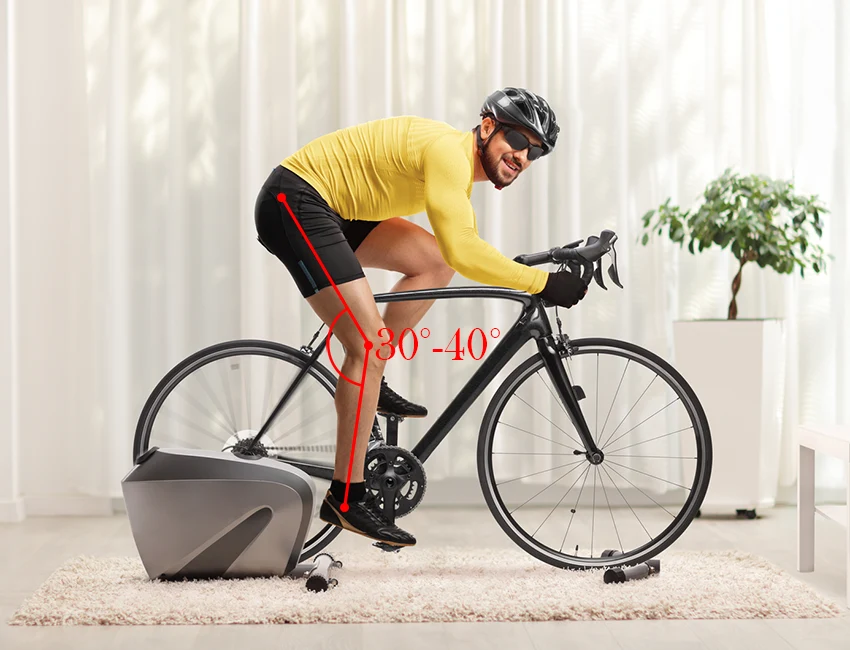
Setting the saddle height correctly has a very important impact on the overall bike fit.
If the saddle height is too low, you won’t be able to transfer power to the pedals effectively and your legs may fatigue more quickly. I have experienced that firsthand in mountain bike racing—when the saddle falls down by one inch from its ideal position, I lose about 25-50% of my power.
Now that we know how important finding the perfect saddle height is, how should we do it?
The easiest way is to:
- Hop on your bike wearing the shoes that you typically use for cycling (flat or clipless).
- Lean against the wall for support or have someone help you stay in an upright position. You can also use a bike trainer for this purpose.
- Push the pedal down to its lowest point (6 o’clock) while keeping the foot parallel to the ground.
- At this point, you should have a slight bend in the knee, as shown in the image above. Adjust the saddle height accordingly until you achieve it.
The next step is to go outside and ride. Does it feel good? If not, then make further minimal adjustments (a few millimeters at a time) until the saddle height feels natural, your power transfer is optimal, and you’re not feeling any pains or aches.
Related: Check Out The Best Fat Tire Bikes
 Bicycle Guider’s TIP:
Bicycle Guider’s TIP:
Once you’ve determined your ideal saddle height, it’s a good idea to mark that position with a marker, as saddles can lower with time. Some bikes come with height indicators on the seat post, so make sure to remember the correct marking for future reference.
MTB Geometry Guide
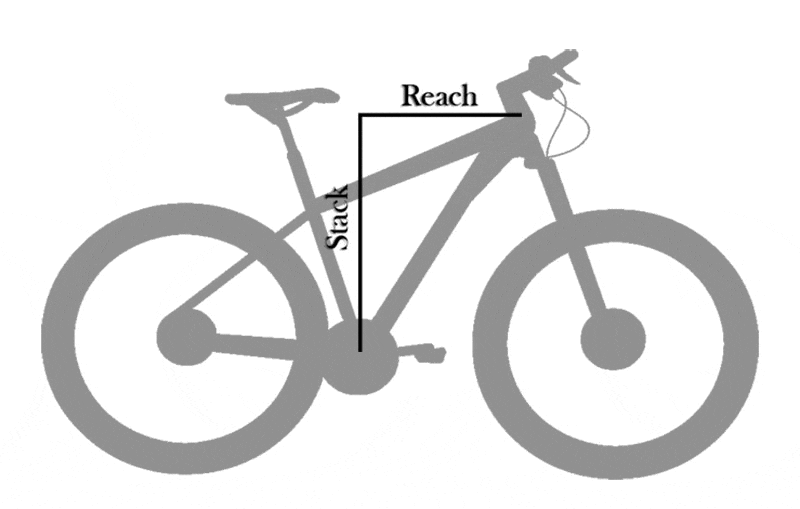
Mountain bike geometry refers to the actual shape of the bicycle, the measurements of different tubes and angles, and their relations to each other.
Here’s a brief guide on the most important measurements you need to be aware of to get the right fit:
- Reach: This measurement refers to the horizontal distance between the center of the bottom bracket to the top center of the head tube. It affects the length of the bike and the overall stability and ride feel.
- Stack: Refers to the vertical distance between the center of the bottom bracket to the top center of the head tube. It affects how upright your position will be and how tall the handlebar will be.
- Standover height: This is the height from the ground to the top of the top tube. Make sure that this measurement is at least an inch shorter than your inseam length to be able to stand over the bike with both feet flat on the ground.
- Wheelbase: This is the distance between the centers of both wheels. A shorter wheelbase provides more agility, while a longer wheelbase improves stability.
- Head tube angle: This is the angle between the ground and the bike’s fork. A slacker angle (lower number) means the bike is more stable on rough terrain, while a steeper angle allows more responsive steering.
- Seat tube angle: This measurement refers to the angle between the ground and the seat tube. A steeper angle improves climbing ability, whereas a slacker angle is better for descending.
How to Choose When In-Between Two Sizes?
So you’ve consulted a mountain bike size chart or an online calculator and the results put you right in the middle of two sizes. What do you do? Should you size up or size down?
Each option has some pros and cons and the final decision depends on your:
- Flexibility
- Leg-to-torso length ratio
- Riding style
Here are some of the most important factors to consider when deciding whether to get a one size bigger or smaller mountain bike.
When to Size Up?
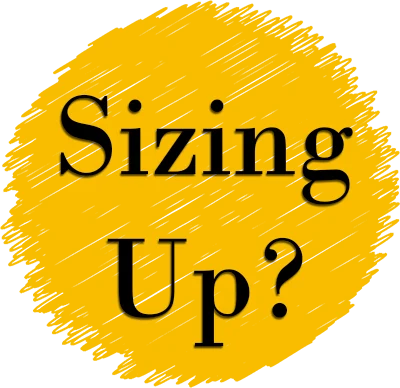
Mountain bikes grow in length (reach) and in height (stack) with each frame size. But modern mountain bikes grow more in length (reach), which is why this is a more important measurement to consider.
Assume you are in between two sizes and you decide to size up. You’ll get a bike with a longer top tube and a longer wheelbase, which means your handlebar will be further away from the saddle.
How does this affect the factors we’ve mentioned above?
Flexibility: This is a good option for riders who are flexible and can easily reach their toes when bent over. A longer top tube means you will need to hinge more at the hips, which can be painful and uncomfortable if you’re stiff and have a short range of motion.
Leg-to-torso length ratio: If you have short legs and a long torso, you should size up when buying a mountain bike as this will give you a more neutral fit. But make sure that the standover height is not too high so that you can’t stand over the bike comfortably.
Riding style: Finally, a larger frame size translates to a longer wheelbase, which means the bike will be more stable on rough terrain and go over obstacles with more ease, but it will feel less playful and more difficult to maneuver.
When to Size Down?
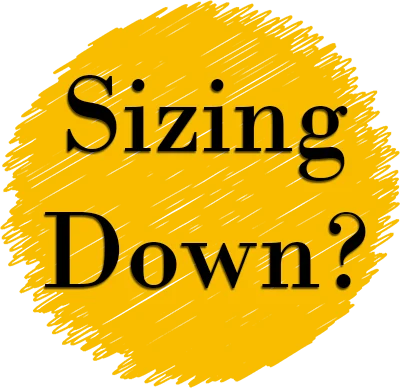
Similarly, a smaller mountain bike will have a significantly shorter reach and a slightly shorter stack and wheelbase. A smaller bike will also have a shorter maximum seat post height, so you may need to extend it depending on how long your legs are.
So how does this relate to the three most important factors mentioned above?
Flexibility: If you are not a flexible person and you struggle to reach your toes with your fingers, then you’ll benefit from a shorter reach a smaller mountain bike frame size offers. It will put you in a more upright riding position, with handlebars closer to your body, which means you can ride for longer without experiencing discomfort.
Leg-to-torso length ratio: Sizing down is a logical choice for riders who have longer legs and shorter torsos. This way, the bike will feel more comfortable, but you may need to use a longer seat post to get the proper leg extension.
Riding style: A smaller mountain bike with a shorter wheelbase will feel more nimble, playful, and easier to handle over rough terrain. If you like flicking your rear wheel and going around obstacles instead of plowing through them, a smaller bike is the right choice.
What If I Still Got the Wrong Bike Size?
Sometimes, even after going through all the methods and consulting several mountain bike size charts, you may find that the bike doesn’t feel right and that you’ve probably chosen the wrong bike size.
Don’t worry, if you’re off by one size or even half a size, there are easy fixes you can try to improve the comfort and fit!
The first thing to do is to contact the retailer/manufacturer and try to get a replacement. Under the right conditions, you’ll be able to get a different frame size bike without significant additional costs.
If you don’t want to go through the hassle of shipping the bike or this option is not available, you can try the following things:
- Adjust the fore-aft position of the saddle: The fore-aft position of the saddle can be adjusted slightly to lengthen or shorten the reach. Make sure not to overdo it so your knee doesn’t end up too far in front or behind the middle of your foot when in the 3 o’clock position.
- Replace the stem: By using a longer or a shorter stem, you’ll be able to increase or shorten the reach by a few centimeters. In most cases, this will be enough to significantly improve the feel and ride quality.
- Replace the seat post: If you bought a bike that is too small and you can’t extend the leg fully when pedaling, consider using a longer seat post.
- Replace the handlebar: A shorter handlebar will be easier to reach and will put you in a less stretched-out position and vice-versa. If you’re using drop bars, consider getting a model with a shorter or longer reach to fine-tune your fitment.
- Raise the handlebar: You can easily achieve a more upright riding position and increase the stack measurement by raising the handlebar with headset spacers. If there are headset spacers above your stem, simply move them underneath to move the stem and handlebar higher up.
- Get a professional bike fitting: A professional bike fitter can do all of these steps for you, which is the best option you have, but also the costliest.
Most importantly, give yourself time to get accustomed to your new bike. Sometimes, your body needs a few days or weeks to adjust to the new riding position.
I remember when I got my first 29er mountain bike. It felt huge and I found it difficult to ride it on narrow winding trails and on technical terrain. However, now that I’m used to the 29er, the 26″ mountain bike seems almost comically small.
Mountain Bike Reviews
Are you in the market for a new mountain bike? Start with one of our mountain bike buying guides below:


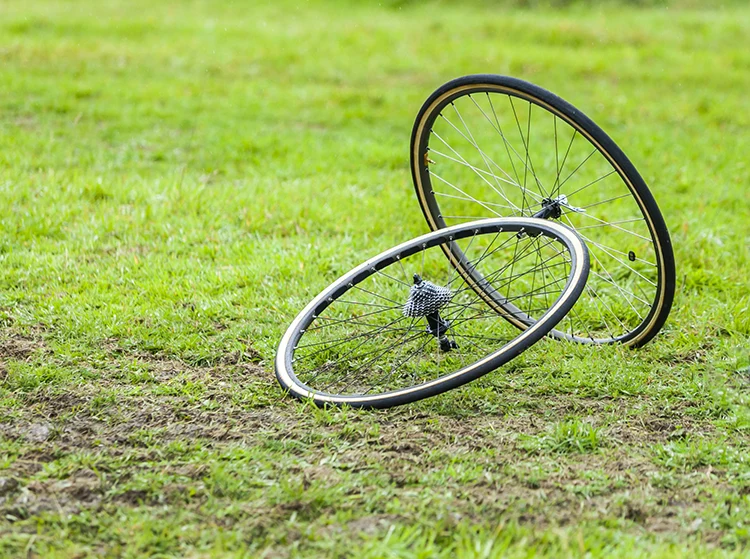
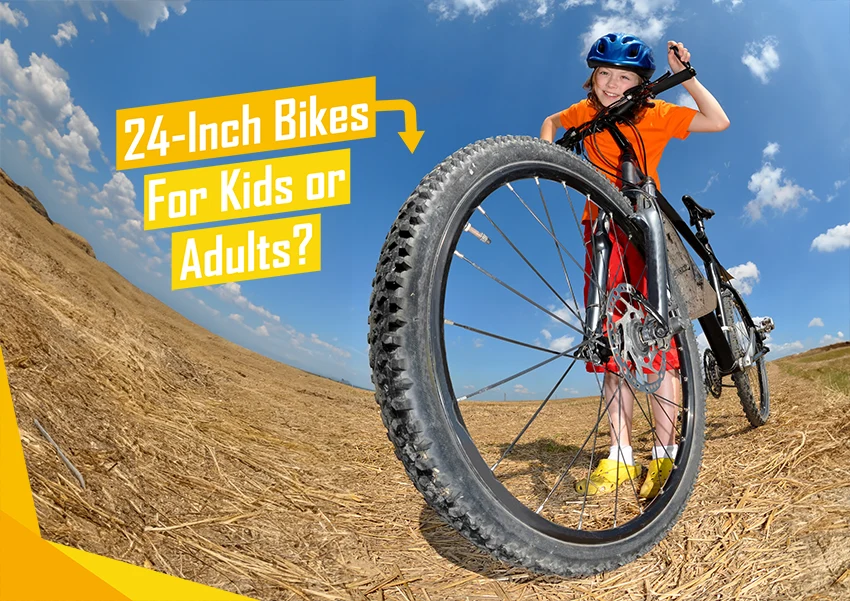
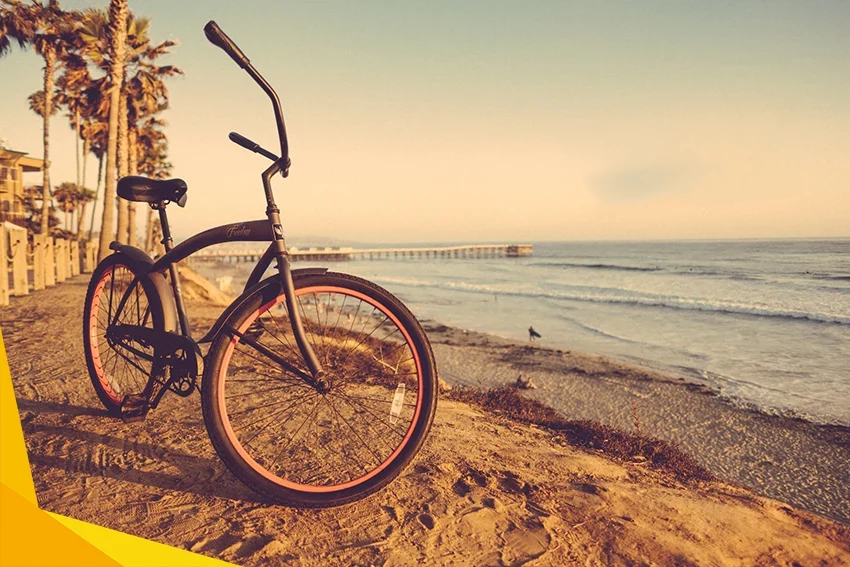
Hi Jeff,
I’m looking to buy a new mountain bike. I am a woman, 5’7″ tall, but with a 33″ inside leg, which means I don’t fit with the charts as I’m supposed to have shorter legs for my height according to them! I currently have a 19.5″ men’s Mongoose Sycamore mountain bike, with 26″ wheels, much loved, which I’ve owned for 25 years, which is a bit knackered and I’m looking to replace it. I have the saddle height very close to the lowest setting, though. I’d be looking for a men’s bike again as I can’t stand the somewhat sexist girly colours and styling of the women’s bikes and most only seem to go up to 18″. Trouble is, most bikes nowadays seem to come in either 18″ or 20″, and 27.5″ or 29″ wheels. Due to the current situation, I need to buy online as I can’t try bikes out. What size do I go for, and what size wheels?! I’d be riding on a combination of roads and off-road tracks and grassland, but not doing any serious mountainy stuff!
Also, what brands are good, looking to spend about £500?
Thanks!
Jen
Hey Jen! Considering you have a much longer inseam length than average for your height, I’d recommend going for a slightly smaller frame size that would accommodate your upper body. I believe an 18″ MTB with 27.5 wheels would be a good choice.
As for the brands and specific bike recommendations, we wrote about cheap mountain bikes here and here.
Check it out and you might find something you like. 🙂
Hi Jeff, I found out the inseam measurement can be prone to introduce errors depending on how is made…I guess the right way should mimic us sitting in the bike?, some suggest using a book and push it up in between the legs….I initially just loosely measured myself which gave me a strange inseam way off my “proportionate” height ….perhaps adding some guidelines for this may help for consistency. Thanks for the article!.
Hi Miguel, thanks for the recommendation. Yes, the book measurement technique is quite popular, we’ll consider updating this information and explaining it further. 🙂
Hi Jeff,
Thank you for the prompt response.
I was also leaning towards the BTwin.
Could you please clarify the pros of the 26 over a 29; besides the easy availability of spares.
I have ridden similar terrains on both a 700c Hybrid & 29er (in fact it was a Trek X Cal | XL). But that was first time on a MTB, so don’t have a proper perspective.
Thanks again.
One of the benefits is that 26″ wheels are usually stronger because of significantly shorter spokes. There’s much less torsion in them. If you plan to pack heavily, that’s a good reason to go with 26″.
You can also fit wider tires because of more tire clearance, which can come in handy when riding in the Himalayan Mountains. They’re a bit slower than 29ers, but you’ll be more stable thanks to a lower balance point.
Feel free to send us a few photos when you’re back and share some impressions. 🙂
Hi Jeff,
Extremely helpful post. I needed some advise regarding frame & tire sizing.
I’m 5ft 11.5 inches | 182 cm with an inseam of 33.5 inches. I currently ride a Road bike | 56 inch frame with a 40mm stem & it still feels slightly stretched.
Looking to buy a used MTB for multi-day touring in the Himalayan Mountains.
Found two options:
1. Trek X Caliber 8 | XL | 21.5 inches | 29″ wheels | Shimano Deore
brakeset | Shimano M395 hydraulic disc brakes | chainset Shimano M522, 42/32/24 | rear derailleur Shimano SLX | SR Suntour XCR-RL 100mm
2. BTWIN RAFAL 740 | M | 18 inches | 26″ wheels | SRAM X9 (rear) and SRAM X7 (front) | 160 mm AVID DB3 brakes | SRAM X7 PUSH PULL type shifters | 100 mm Marvel Manitou PRO
Please Advise! Thanks in advance!
Well, size-wise, neither of the two is perfect. Trek (XL) is one size too big, whereas BTWIN (M) is one size too small. It’s a decision you’ll have to make. Considering you’ll be traveling in the Himalayan Mountains, I’d go with BTWIN. 26″ wheels and tires are much easier to find and service there, which is a big consideration when you’re out and exposed. Also, a one-size smaller frame is a better choice in this case since you say you feel stretched out even on a 56 cm road bike frame. Have fun on your trip! 🙂
Hello your article is very helpful but I am confused. I’m 5’4 and my inseam is 30″ should I go with 26 or 27.5. I’m really confused.
You can ride either of the two, depending on the specific bike you’re considering. If the standover clearance on the 27.5″ model is suitable for your inseam length, you’ll have no other problems. Just make sure you get the right frame size.
Hey Jeff, 5’7 height, inseam is 28”, is 17-19 inches ok for me? What do you recommend in terms of a bike with disc brakes, hard tail or full suspension? Plan to use the bike for casual riding as well as some trail riding. Looking to get back into the biking world. Thanks!
Hi Eric, a 17″ frame would be a good fit for you. I recommend getting a hardtail as it’s more versatile and it’s more affordable as well, considering you’re only just getting back into the cycling world. Have fun! 🙂
Hi, we are looking for a bike for my son.he is 6.6 but has a 34-36in inseam. He has tried a friends large and xl. Both fit. We’ve had a couple folks say xxl. Now my real question is where do we measure the bike to get that 21cm or more frame size cause some folks tell us numbers and some general size (like trying on clothing…aaagh). Most folks in the used in just put 26 but I know that tire and that doesn’t help.
Muchas gracias
Hi Sonia, mountain bikes are measured in inches. So, ideally, your son would need a 21″-23″ bike to fit him well. You need to measure the seat tube from the center of the bottom bracket to the top of the seat tube. A 29er would be a good choice for him as well. 🙂
Hi Jeff. Thanks for the article.
I am 5’11 and I was looking at the first chart and gives me 18”-19” but when I saw the second chart I found my self at large frame.
Right now I found an used bike frame 18.5” and the owner size is 5.9” and I don’t know what to follow here. You help us very appreciate.
Thank you.
Hi Adel, you are just in-between sizes there. An 18.5″ frame could be just right for you, but it could also be slightly too small. Check the manufacturer’s size charts to make sure it fits you.
I am 6ft and weigh 90kgs candi ride a 27.5er?
Sure, I don’t see any reason why not. 🙂
What do you recommend for a bosh system Mt ebike full suspension under $4K?
Hi Grant, we recently wrote about our favorite full suspension ebikes here: https://www.bicycle-guider.com/best-mountain-bikes/
Our choices fit your wallet as well! 🙂